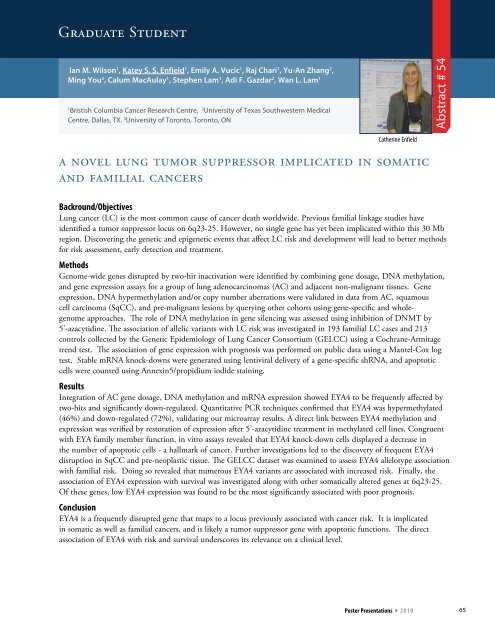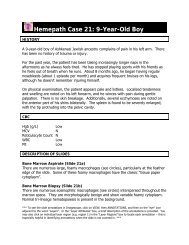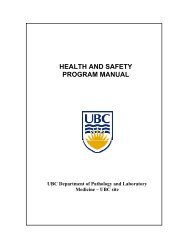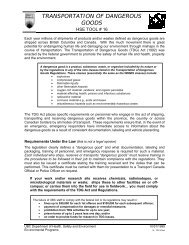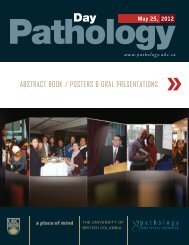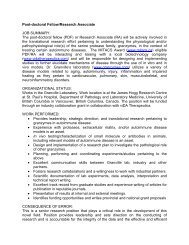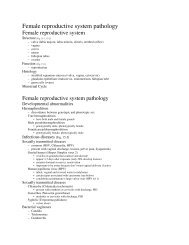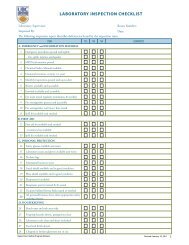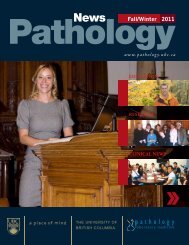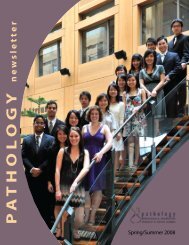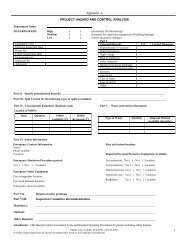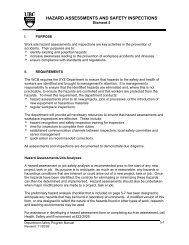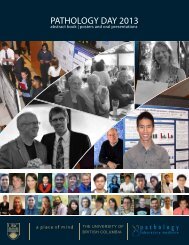Oral Presentations - Pathology and Laboratory Medicine - University ...
Oral Presentations - Pathology and Laboratory Medicine - University ...
Oral Presentations - Pathology and Laboratory Medicine - University ...
You also want an ePaper? Increase the reach of your titles
YUMPU automatically turns print PDFs into web optimized ePapers that Google loves.
Graduate StudentIan M. Wilson 1 , Katey S. S. Enfield 1 , Emily A. Vucic 1 , Raj Chari 1 , Yu-An Zhang 2 ,Ming You 3 , Calum MacAulay 1 , Stephen Lam 1 , Adi F. Gazdar 2 , Wan L. Lam 11Bristish Columbia Cancer Research Centre, 2 <strong>University</strong> of Texas Southwestern MedicalCentre, Dallas, TX. 3 <strong>University</strong> of Toronto, Toronto, ONAbstract # 54Catherine Enfielda novel lung tumor suppressor implicated in somatic<strong>and</strong> familial cancersBackround/ObjectivesLung cancer (LC) is the most common cause of cancer death worldwide. Previous familial linkage studies haveidentified a tumor suppressor locus on 6q23-25. However, no single gene has yet been implicated within this 30 Mbregion. Discovering the genetic <strong>and</strong> epigenetic events that affect LC risk <strong>and</strong> development will lead to better methodsfor risk assessment, early detection <strong>and</strong> treatment.MethodsGenome-wide genes disrupted by two-hit inactivation were identified by combining gene dosage, DNA methylation,<strong>and</strong> gene expression assays for a group of lung adenocarcinomas (AC) <strong>and</strong> adjacent non-malignant tissues. Geneexpression, DNA hypermethylation <strong>and</strong>/or copy number aberrations were validated in data from AC, squamouscell carcinoma (SqCC), <strong>and</strong> pre-malignant lesions by querying other cohorts using gene-specific <strong>and</strong> wholegenomeapproaches. The role of DNA methylation in gene silencing was assessed using inhibition of DNMT by5’-azacytidine. The association of allelic variants with LC risk was investigated in 193 familial LC cases <strong>and</strong> 213controls collected by the Genetic Epidemiology of Lung Cancer Consortium (GELCC) using a Cochrane-Armitagetrend test. The association of gene expression with prognosis was performed on public data using a Mantel-Cox logtest. Stable mRNA knock-downs were generated using lentiviral delivery of a gene-specific shRNA, <strong>and</strong> apoptoticcells were counted using Annexin5/propidium iodide staining.ResultsIntegration of AC gene dosage, DNA methylation <strong>and</strong> mRNA expression showed EYA4 to be frequently affected bytwo-hits <strong>and</strong> significantly down-regulated. Quantitative PCR techniques confirmed that EYA4 was hypermethylated(46%) <strong>and</strong> down-regulated (72%), validating our microarray results. A direct link between EYA4 methylation <strong>and</strong>expression was verified by restoration of expression after 5’-azacytidine treatment in methylated cell lines. Congruentwith EYA family member function, in vitro assays revealed that EYA4 knock-down cells displayed a decrease inthe number of apoptotic cells - a hallmark of cancer. Further investigations led to the discovery of frequent EYA4disruption in SqCC <strong>and</strong> pre-neoplastic tissue. The GELCC dataset was examined to assess EYA4 allelotype associationwith familial risk. Doing so revealed that numerous EYA4 variants are associated with increased risk. Finally, theassociation of EYA4 expression with survival was investigated along with other somatically altered genes at 6q23-25.Of these genes, low EYA4 expression was found to be the most significantly associated with poor prognosis.ConclusionEYA4 is a frequently disrupted gene that maps to a locus previously associated with cancer risk. It is implicatedin somatic as well as familial cancers, <strong>and</strong> is likely a tumor suppressor gene with apoptotic functions. The directassociation of EYA4 with risk <strong>and</strong> survival underscores its relevance on a clinical level.Poster <strong>Presentations</strong> * 2 0 1 065


